Cover story: Majestic Horse Floats
The story of Majestic Horse Floats spans over a few decades. So it’s no wonder that for a company that’s been in business for so long, they’ve earned a reputable name in the country.
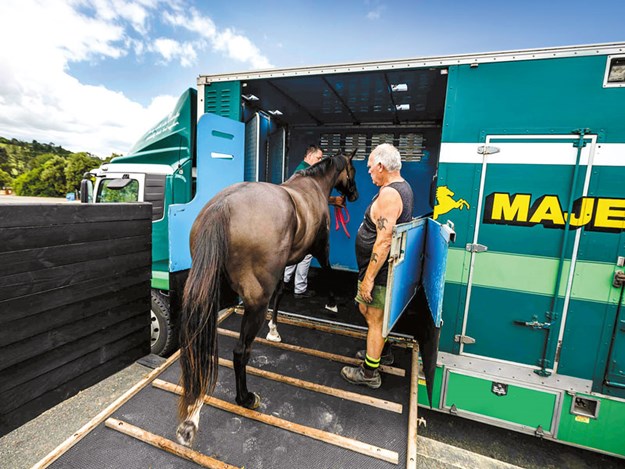 |
|
Most horses are float trained but a few need extra coaxing
|
Majestic Horse Floats have been transporting horses since 1938. Chalking up these many years in business is no mean feat, and the company is rightly proud of their record. Ward Austin, the CEO of Majestic Horse Floats and who’s been at the helm for three years, says it’s a specialised business.
 |
|
Ward Austin
|
He has a background in logistics and distribution. "Horses are interesting cargo," he says. "They range in value from being worth millions of dollars to a pony worth $200, but whatever their value, they represent a big emotional and financial investment to their owners."
Skilled in horsemanship
Equine transport drivers not only have to be excellent drivers but they also must have a thorough understanding of horses and be passionate about their job. "Horses can be difficult to load sometimes, so they need to know how to handle them confidently, as well as everything else that might crop up along the way," says Ward.
"Because of the nature of our loads, we tend to go slower and brake carefully around corners. Horses scramble a bit with weight shifts and wind shears, so that’s all taken into account when driving."
People from a variety of equine backgrounds are drawn to transporting horses. "We have all sorts, from retired horse trainers to a former chemist who loves ponies and trains them. We have women who have been track-riders or pony club members. We’ve also got drivers from the thoroughbred game, retired or injured jockeys who can’t ride any more but still have that passion for the horse."
With one driver on the job for each load, it’s up to them to manage problems encountered in transit. Again, horses are unlike any other freight and drivers can’t just pull over and stop on the side of the road to sort matters out. There’s always a Plan B in place.
"We rely heavily on others in the industry, so if anything happens, the driver goes to a controlled property or one of our depots, where there’s someone to help. We make su0e they’re in an environment that doesn’t create more risk. We want to eliminate that."
Ward adds that they deal with everything, from yearlings, weanlings, broodmares, geldings, ponies, and stallions that might be worth 30 million dollars on the hoof.
.jpg) |
|
Pulling into the Ramarama depot after a trip from the Lower North Island
|
"We have a client with a stud in Masterton, where a stallion travels from the northern hemisphere. We send one of our trucks to the airport and pick him up in Auckland. He’ll go in the truck by himself. Stallions don’t need much encouragement to get territorial."
Horses can be temperamental, says Ward. "They can be the worst of enemies when you put them on the truck at Ramarama, and when you take them off at Pokeno, you’d think the world had ended, but suddenly, they are best mates."
Big rigs
 |
|
In-house mechanics always have their finger on the pulse for any necessary maintenance work
|
Majestic runs Nissan UD 250hp trucks for seven horse loads and UD (Nissan) 280hp for nine horse loads. On the interisland run, they have a Scania with a trailer that holds up to 15 horses and which provides increased driver comfort over the longer routes.
Ward says, "We’ve been with Nissans for many years; they look after us well and offer us great service and have a thorough understanding of our business needs. As well, we have our mechanic who can fix anything and get us back on the road quickly. Just like any trucking company, that’s very important to us."
Majestic has an in-house team who construct the body inside the boxes with an experienced fleet manager to oversee the operation.
"Boxes get built in-house from scratch to specific design standards. We have a model that works very well, and we stick to that. We can’t do anything different. We can make tweaks but are only going to be stuck with configurations of nine or seven compartments. However, we can break compartments up, depending on the type of horses onboard."
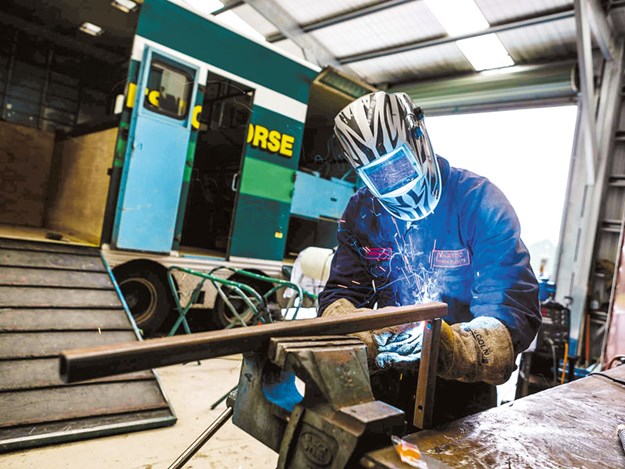 |
|
Running repairs are done in the workshop
|
Every year, two floats have cab chassis replaced with new ones. "We expect to complete 10 years or a million kilometres per cab chassis. The floats themselves (horseboxes) last on average for 20 years. We normally also complete two new builds per year."
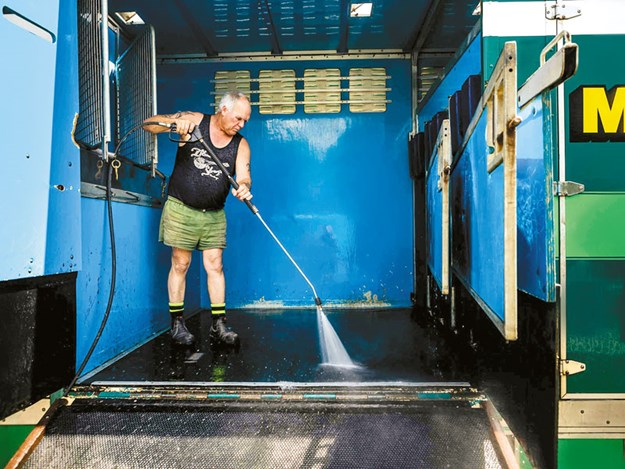 |
|
Horse boxes are given a through wash after each trip
|
Each horsebox has viewing or ventilation hatches that open so the horses can see each other. "We have to be careful if we have colts or stallions; they can’t be looking at broodmares or fillies because all of a sudden, it’s, ‘hello’. However, we can close them off, so they don’t get so territorial. Our gelded friends can go next to anybody."
Horses are not fed on route, as they cannot clear airways should there be a choking issue. Most journeys are not overly long in terms of hours. "Longer journeys are broken up with feed and water at our depots and overnight rest, which is important," says Ward.
Communications
When it comes to communicating en route, drivers and the office are in contact via mobile phone and RT (mobile two-way radio). A camera in the cab allows drivers to see what’s happening in the horseboxes, and they are quick to detect if one of the horses needs attention.
Loading and unloading
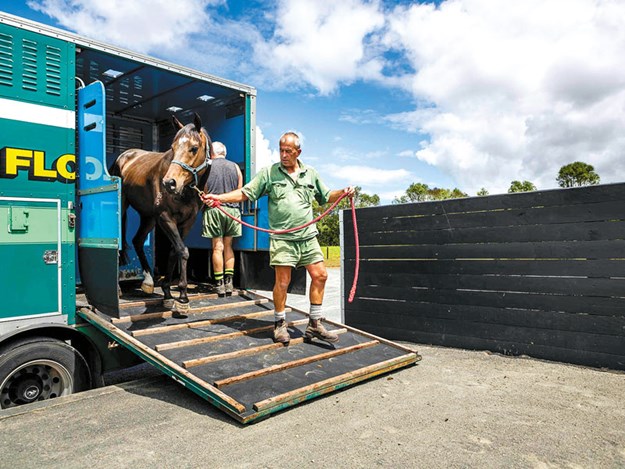 |
|
Horses are loaded via side doors only
|
Most horses are float trained and are used to being transported. "Someone is always on-site when we’re delivering or picking up. Studs and racing stables do have loading ramps, which make it easier. They often have chutes, so a horse doesn’t have the opportunity to misbehave or put up resistance; this way, we can control them, compared to loading them on a ramp.
If a horse is not confident, we have techniques to encourage them. Sometimes we even back them up into the float. "Understanding is everything. We do get times we can’t pick a horse up, so we make the call to leave them and return later. It usually works the second time around."
Clientele
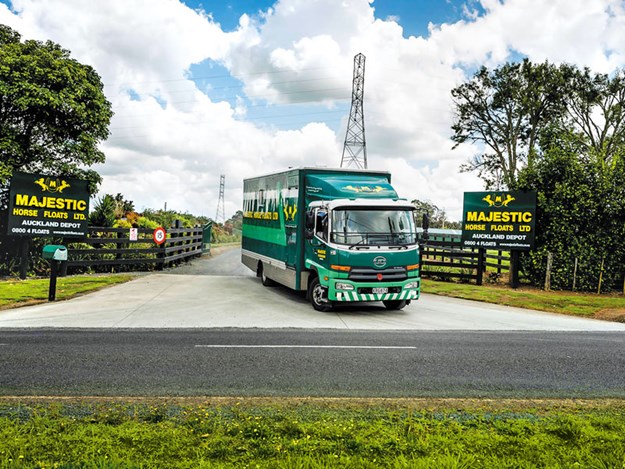 |
|
Majestic Horse Floats’ location in Ramarama means easy access to Auckland Airport
|
Majestic Horse Floats’ clients range from large horse breeding studs through to individuals.
"We are heavily involved with Te Akau Stud in Waikato, Marsh Racing in Cambridge, and All Stars Stables in Canterbury. So, we have the top end of the market, and we also have the guy with a few horses who has just started and may not have a truck.
"We’ve got clients in the stud market; some have their own trucks and we help them out around sale time because they can’t physically move everything. Airfreight companies use us to get horses to the airport, too."
Lockdown impact
Like many other businesses, Majestic Horse Floats felt the effects of the COVID-19 lockdown. "Because of the lockdown, prime racing season has been on hold; the first real meeting of thoroughbreds was on 20 June at Pukekohe. Standardbreds started some weeks earlier.
"It will be interesting to see what happens over the next few months as we get into more racing. Hopefully, we won’t see too much impact through October, November, and December. Prior to this, there’s a limited racing calendar, and while it’s not the core of our business, it provides the simmer: the sizzle is the activity associated with it. It all adds up.
Like many others who are in business, if you lose a portion of your business, you’ve got to replace it somehow, or do other things to make it work," says Ward. You can be sure, though, that with their long track record in the horse transport business, Majestic Horse Floats will come up with innovative solutions to fill any gaps.
Quick facts
- Majestic Horse Floats work New Zealand wide
- Thirty-five transporters across the country
- Offices, stables and depots in Auckland, Cambridge, Matamata, Palmerston North, Bulls, Christchurch, and Invercargill
- 54 staff with a pool of 33 full-time drivers
- All aspects of horse transport are covered, including local jobs, inter-island transport, to and from airports, race meetings, stud work, mares with foals, pony club transport, and a variety of sport horse work
Company history
Majestic Horse Floats was started in 1938 and was pretty much based in the Lower North Island. The fleet and the business increased its presence in the 1980s after purchasing Thoroughbred and White Star Horse Transport. In the early ’90s, under the ownership of John Kenny, on-time delivery and communication became the cornerstone of the businesses ethos.
Further acquisition of other companies in the mid-2000s gave scope and size and added in valuable depots around the country. In 2016, John Kenny sold to Castlerock Partners, which has seen the strong ethos and investment in the business continue and will do so for the decades
to come.
For more information, visit majesticfloats.co.nz.
Keep up to date in the industry by signing up to Deals on Wheels' free newsletter or liking us on Facebook.





.jpg)


.jpg)


.jpg)
.jpg)
.jpg)

.jpg)

